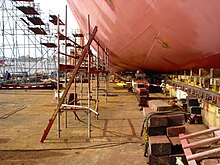Slipway


A slipway (also (the) Helgen ) is originally understood to mean the place in the shipyard where a ship is built, more precisely the sloping surface on which it is then lowered into the water when it is launched.
Components
In contrast to the dock , in which ships are repaired, slipways are often used to build new ships. Work on smaller ships can also be carried out on a helgen, such as caulking wooden ships.
The supports that hold a boat or ship that is on dry land are also known as slipways . But here are the names bracing or Pallungen common and known.
The slipway or the Helgen consists of three parts:
- the Helgenbock,
- the malls or mall frames and
- the donkey.
The Helgenbock
For smaller vehicles, the Helgen is usually a horizontal wooden plank , the thickness and length of which is determined by the type of boat. It should be a little longer than the later hull of the boat , whereby the cross-section must be sufficiently dimensioned according to the weight of the resulting boat.
The supports should be spaced appropriately to prevent the beam from sagging. In addition, make sure that the Helgenbock is exactly horizontal and that the midship line (MS) is marked so that the mall frames can be aligned with it later. In order to be able to work under the boat hull, the Helgen beam should be placed about half a meter above the ground.
In order to take account of the keel jump , the Helgen must be adapted to the keel. This can be done (based on the keel stacking plan) either with stacking blocks or by adjusting the helm beam (in series production ).
The Helgenbock is installed on the ground for larger ships that have to be lowered into the water due to their weight at the construction site. It is then no longer horizontal , but has an angle of inclination of around 4–5 degrees , which corresponds to a tangent of 1:14 to 1:12. This inclination enables the ship to slide into the water under its own weight after completion.
The malls or bulkheads
Malls are frame templates that are used to shape the later plank corridors . In principle, one distinguishes between mall frames and building frames. When a scaffolding is made up of mall frames, it is commonly referred to as a mall scaffolding . The term frame structure is used for a frame made of structural frames . Mall frames are used for shaping and are removed from the finished fuselage shell. For this reason, they are also known as temporary frames or auxiliary frames . Structural frames are parts of the later hull and are connected to the hull during the construction phase. Thus, for example, bulkheads are also referred to as building frames .
The mall frames are taken 1: 1 from the frame plan (part of the construction drawing). For the construction of wooden boats that must hull strength when splitting up of the body plan are deducted specified width. The so-called mall edge is created. In the case of steel boats, the mall edge is already drawn in the frame crack, so that "later correction" is not necessary. In wooden boats, the frames are placed on the side of the mall edge facing away from the main frame (frame at the widest point of the boat), in steel structures on the side facing the main frame.
Today, the mall frames are mostly made from chipboard or plywood , as they do not warp (like solid wood) and are significantly cheaper than solid wood in price. The malls consist of several parts that are connected by mall tabs . When manufacturing the mall frames, care should be taken to insert a recess for the keel (keel cutout), longitudinal frames , chimney etc. if necessary . For stiffening and marking, a crossbar is attached to the height of the construction waterline (KWL) and one to the height of the Schandeck (width bar) on the main bulkhead. The mall frames must be exactly vertical on the Helgen beam (both KWL battens and width battens must be horizontal). For a better overview, the individual malls are numbered and provided with the construction number of the boat.
The donkey
The donkey is an auxiliary construction just above the Helgen beam. Slats are attached to it that hold the mall or model frames in position.
Practical Approaches
The procedure described here is particularly suitable for larger ships that are more traditionally built. Smaller boats, which are easy to lift or turn due to their lower weight, can also be built upside down ("upside down"). This makes it easier to work on the mallet or frame structure, as planking (especially in the floor area) does not have to be done overhead and the hull is at an easily accessible working height.
In modern construction methods, a block model is often used instead of the mallet framework. Here, the existing mallet structure, which already clearly defines the boat shape, is covered with veneer layers , plywood panels or GRP bandages to form a closed block. This makes it possible to produce molded hulls or molds for plastic boat construction.
literature
- Jürgen Gebauer, Egon Krenz: Marine Encyclopedia . Brandenburg publishing house in the Dornier Medienholding, Berlin 1998, ISBN 3-85492-757-6 , page 122
- E. Vlig: Problems with the launch . 1st edition. ultramarin, Cologne 2011 ( lex-ikon.eu [PDF]). Translated from J. Th. Wilke, S. Halfweeg: De problemen van den stapelloop - De tewaterlating in hair voorbereiding . In: Neerlands Scheepsbouw en Scheepvaart . tape 1 : Scheepsbouw . Rotterdam, S. 59-79 (first edition: Wyt Uitgevers, 1943). , Pp. 1-18.

